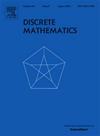Thresholds for pebbling on grids
IF 0.7
3区 数学
Q2 MATHEMATICS
引用次数: 0
Abstract
Given a connected graph G and a configuration of t pebbles on the vertices of G, a q-pebbling step consists of removing q pebbles from a vertex, and adding a single pebble to one of its neighbors. Given a vector , q-pebbling consists of allowing -pebbling in coordinate i. A distribution of pebbles is called solvable if it is possible to transfer at least one pebble to any specified vertex of G via a finite sequence of pebbling steps.
In this paper, we determine the weak threshold for q-pebbling on the sequence of grids for fixed d and q, as . Further, we determine the strong threshold for q-pebbling on the sequence of paths of increasing length. A fundamental tool in these proofs is a new notion of ‘centralness’ and a sufficient condition for solvability based on the well used pebbling weight functions; we believe this to be the first result of its kind, and may be of independent interest.
These theorems improve recent results of Czygrinow and Hurlbert, and Godbole, Jablonski, Salzman, and Wierman. They are the generalizations to the random setting of much earlier results of Chung.
In addition, we give a short counterexample showing that the threshold version of a well known conjecture of Graham does not hold. This uses a result for hypercubes due to Czygrinow and Wagner.
网格上的鹅卵石的阈值
给定一个连通图G和G顶点上的t个卵石的构型,一个q- pebble步骤包括从一个顶点移除q个卵石,并向它的一个邻居添加一个卵石。给定一个向量q=(q1,…,qd), q- pebble包括在坐标i中允许qi- pebble。如果有可能通过有限序列的pebble步骤将至少一个鹅卵石转移到G的任何指定顶点,则称为可解的鹅卵石分布。在本文中,我们确定了网格序列[n]d上对于固定的d和q,当n→∞时q- pepoding的弱阈值。进一步,我们确定了长度递增的路径序列上q- pebble的强阈值。这些证明的一个基本工具是一个新的“中心性”概念和基于常用的卵石权函数的可解性的充分条件;我们认为这是此类研究的第一个结果,可能会引起人们的独立兴趣。这些定理改进了Czygrinow和Hurlbert,以及Godbole, Jablonski, Salzman和Wierman最近的结果。它们是对Chung更早的结果的随机设置的推广。此外,我们给出了一个简短的反例,表明格雷厄姆的一个著名猜想的阈值版本并不成立。这使用了Czygrinow和Wagner提出的超立方体的结果。
本文章由计算机程序翻译,如有差异,请以英文原文为准。
求助全文
约1分钟内获得全文
求助全文
来源期刊

Discrete Mathematics
数学-数学
CiteScore
1.50
自引率
12.50%
发文量
424
审稿时长
6 months
期刊介绍:
Discrete Mathematics provides a common forum for significant research in many areas of discrete mathematics and combinatorics. Among the fields covered by Discrete Mathematics are graph and hypergraph theory, enumeration, coding theory, block designs, the combinatorics of partially ordered sets, extremal set theory, matroid theory, algebraic combinatorics, discrete geometry, matrices, and discrete probability theory.
Items in the journal include research articles (Contributions or Notes, depending on length) and survey/expository articles (Perspectives). Efforts are made to process the submission of Notes (short articles) quickly. The Perspectives section features expository articles accessible to a broad audience that cast new light or present unifying points of view on well-known or insufficiently-known topics.
 求助内容:
求助内容: 应助结果提醒方式:
应助结果提醒方式:


